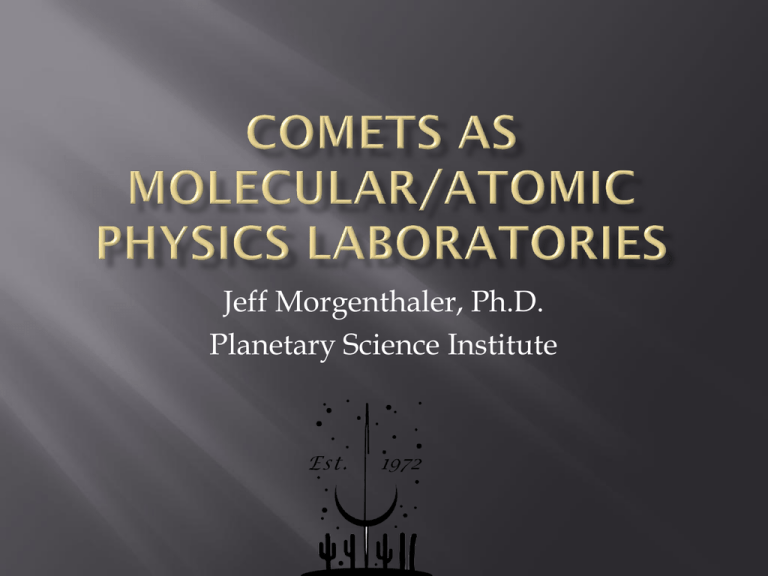Comets as Molecular/Atomic Physics Laboratories
advertisement

Jeff Morgenthaler, Ph.D. Planetary Science Institute How to verify a lot of quantum mechanical calculations without doing any quantum mechanics High-quality astrophysics with sophomore-level physics What I did for my summer vacation last year Mike Combi (U. Michigan) Walt Harris (U.C. Davis) Paul Feldman (Johns Hopkins) Hal Weaver (Johns Hopkins Applied Physics Lab) Galaxy Evolution Explorer (GALEX) team Karl Forster (Cal Tech) Tim Conrow (IPAC) Susan Neff (NASA/GSFC) JPL HORIZONS: Jon Giorgini Background What is a comet – why do we care? How do we “measure” comets? Why do we need accurate molecular/atomic physics to measure comets? Measuring the carbon ionization lifetime Next step: CO Along the way: O Final phase: OH Nucleus (10—100 km) Head/Coma (neutral emission lines, 100—106 km) – ballistic motion Dust tail (white, 107 km) Ion tail (blue , 107 km) NASA/JPLCaltech/UMD/McREL Copyright © 1997 by Gerald Rhemann (Austria) Comets are some of the most primordial material left over from the formation of the solar system Solar system formation models Comets may have delivered water and the seeds of life to Earth, maybe Mars, Venus, etc. Amino acids have been observed IDEAL: Cryogenic Nucleus Sample Return (CNSR) Bring back a core sample Billions of dollars Not any time soon Prialnik 2004 Next best thing: Take the lab to the comet Rosetta: European Space Agency (ESA) Orbiter/Lander Comet 67P/ChuryumovGerasimenko Astrium - E. Viktor First approximation: Stardust mission flew through the tail of comet Wild 2 collected comet dust and sent it back to Earth NASA Second approximation: Deep Impact impactor Excavated comet material NASA/JPL-Caltech/University of Maryland/Cornell Deep Impact pre-impact view Stardust revisit Tried and true: Remote sensing Look at what is coming off of the comet and figure out what it is made of Volatiles: Molecule 1P/Halley H2O 100 CO 3.5—11 CO2 3—4 CH4 <0.8 C2H2 0.3 C2H6 0.4 CH3OH 1.8 The Mayall 4-meter telescope at the Kitt Peak National Observatory near Tucson, Arizona. A spectrum is worth a thousand pictures 103P/Hartly 2 (EPOXI target; Weaver et al. 1992) Spectro-imaging is priceless Carbon 1561 Å and 1657 Å multiplets Carbon coma NASA Small Explorer mission Works for comets too! FUV Morrissey et al. 2005 NUV UV Weaver et al. 1992 Visible FUV NUV Different emission lines have different scale lengths NUV Smushed data cube Mcphate et al. 1999 NUV FUV Production rate, Q(C), derived from total emission Q(C) related to C in the nucleus Reality: most instruments don’t “swallow” all the light Aperture corrections Require accurate knowledge of spatial distribution Now measured for carbon (Morgenthaler et al. 2011) Key parameters: = lifetime v = outflow velocity v = scale length Haser (1957) model: Consider comet nucleus isotropically emitting particles at rate Q, velocity v, lifetime . Derivation is left as an exercise to the reader Q n(r) e 2 4r v r v n = number density Q = production rate = lifetime v = velocity r = dist. from comet 2-component Haser model: “Parent/mother” = 1 “Daughter” = 2 k = combination of scale lengths Q n(r) 2 4r v2 k e r v1 1 e r v 2 2 Integrate along line of sight to convert number density to column density Carbon is a daughter species v1~ 1 km/s (bulk outflow velocity) v2~ 4 km/s (ejection velocity) > 3 x 105 km, just carbon ionization Best-fit Haser model determines carbon ionization lifetime Best-fit Haser model determines carbon ionization lifetime Qk n(r) e 2 4r v2 r v2 2 Problem: BACKGROUND! Comet moves: Stars can be erased Background exposure ~1 month prior – good enough? What changes over a FOV of 1 degree? Not the Galaxy Solar system? FUV zodiacal light not bright enough Earth’s atmosphere: Airglow Photochemical effect Correction is analogous to extinction Spent summer vacation picturing GALEX orbit and Earth’s shadow in 3D Aeronomy shadow Sujatha et al. (2009) airglow used solar activity sun orbit Airglow ~uniform over 1 degree Constant offset of background image Solar photoionization only Comet Machholz’s heliographic latitude was 30° during solar min Edge of slow solar wind zone Morgenthaler et al. 2011 For carbon, solar wind can be more important than solar photoionization! IMPORTANT: standard reference (Huebner, Keady, and Lyon 1992) only includes photorates Solar wind ionization important for all longlived species Photo lifetimes > 500,000 s e.g. H, C, O, CO Previous production rates need to be revisited! Comet “carbon puzzle” (Festou 1984) may be solved Verified ionization cross section calculations for carbon over a wide range of photon energies Verified carbon-proton charge exchange cross section Verified carbon-electron collisional cross section Verified ionization cross section calculations for carbon over a wide range of photon energies Verified carbon-proton charge exchange cross section Assume solar spectrum is well known Assume solar wind speed and density well known Verified carbon-electron collisional cross section Assumed comet was in slow solar wind Mcphate et al. 1999 NUV FUV Next step: CO with FUV grism Morgenthaler et al. 2011 Why does [OI] oxygen distribution in Hale-Bopp look like a comet? Metastable [OI] prompt emission really traces H2O and OH Morgenthaler et al. 2001 Residuals aren’t as clean Need 3D coma models – jets, emission asymmetries, ion lines? It is possible to reliably measure atomic and molecular lifetimes using wide-field observations of comets C was easy – isotropic CO will be harder with grism data OH requires sophisticated coma models GALEX could be used as an upper-atmosphere research station (700 km altitude)






